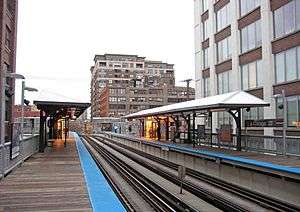Chicago (CTA Brown and Purple Lines station)
| |||||||||||||||||||||||||||||||||||||||||||||||||||||||||||||||||||||||||||||
|---|---|---|---|---|---|---|---|---|---|---|---|---|---|---|---|---|---|---|---|---|---|---|---|---|---|---|---|---|---|---|---|---|---|---|---|---|---|---|---|---|---|---|---|---|---|---|---|---|---|---|---|---|---|---|---|---|---|---|---|---|---|---|---|---|---|---|---|---|---|---|---|---|---|---|---|---|---|
 | |||||||||||||||||||||||||||||||||||||||||||||||||||||||||||||||||||||||||||||
| Location |
300 West Chicago Avenue Chicago, Illinois 60610 | ||||||||||||||||||||||||||||||||||||||||||||||||||||||||||||||||||||||||||||
| Coordinates | 41°53′47″N 87°38′09″W / 41.896467°N 87.635833°W | ||||||||||||||||||||||||||||||||||||||||||||||||||||||||||||||||||||||||||||
| Owned by | Chicago Transit Authority | ||||||||||||||||||||||||||||||||||||||||||||||||||||||||||||||||||||||||||||
| Line(s) | |||||||||||||||||||||||||||||||||||||||||||||||||||||||||||||||||||||||||||||
| Platforms | 2 Side platforms | ||||||||||||||||||||||||||||||||||||||||||||||||||||||||||||||||||||||||||||
| Tracks | 2 | ||||||||||||||||||||||||||||||||||||||||||||||||||||||||||||||||||||||||||||
| Construction | |||||||||||||||||||||||||||||||||||||||||||||||||||||||||||||||||||||||||||||
| Structure type | Elevated | ||||||||||||||||||||||||||||||||||||||||||||||||||||||||||||||||||||||||||||
| Disabled access | Yes | ||||||||||||||||||||||||||||||||||||||||||||||||||||||||||||||||||||||||||||
| History | |||||||||||||||||||||||||||||||||||||||||||||||||||||||||||||||||||||||||||||
| Opened | May 31, 1900[1] | ||||||||||||||||||||||||||||||||||||||||||||||||||||||||||||||||||||||||||||
| Rebuilt | 2006–08 | ||||||||||||||||||||||||||||||||||||||||||||||||||||||||||||||||||||||||||||
| Traffic | |||||||||||||||||||||||||||||||||||||||||||||||||||||||||||||||||||||||||||||
| Passengers (2015) |
1,993,032[2] | ||||||||||||||||||||||||||||||||||||||||||||||||||||||||||||||||||||||||||||
| Rank | 31 out of 143[lower-alpha 1] | ||||||||||||||||||||||||||||||||||||||||||||||||||||||||||||||||||||||||||||
| Services | |||||||||||||||||||||||||||||||||||||||||||||||||||||||||||||||||||||||||||||
| |||||||||||||||||||||||||||||||||||||||||||||||||||||||||||||||||||||||||||||
| |||||||||||||||||||||||||||||||||||||||||||||||||||||||||||||||||||||||||||||
| Location | |||||||||||||||||||||||||||||||||||||||||||||||||||||||||||||||||||||||||||||
 | |||||||||||||||||||||||||||||||||||||||||||||||||||||||||||||||||||||||||||||
Chicago (sometimes Chicago/Franklin, correctly read and announced Chicago and Franklin) is an elevated station on the Chicago Transit Authority's 'L' system, located in the Near North Side neighborhood at 300 W Chicago Avenue at West Chicago Avenue and North Franklin Street in Chicago, Illinois (directional coordinates 800 north, 300 west). The station opened in 1900 as part of the original series of stations on the Northwestern Elevated. There is a high density of art galleries and several schools in the vicinity of the station, including the Moody Bible Institute.
Chicago/Franklin serves the Brown Line, but Purple Line Express trains also stop at the station during weekday rush hours.
Station layout
The original station house was on the north side of Chicago Avenue. Beyond the turnstiles were staircases which led up to the two long side platforms. The Chicago platforms were unusually long, starting just north of Chicago Avenue and curving along the track before straightening out just south of Chicago Avenue. Early in the station's history, it not only served 'L' trains but North Shore Line interurbans as well, requiring longer platforms which could berth eight car trains. The number of tracks also decreased from four to two just north of Chicago, meaning the two track, two side platform station had to provide the same capacity as a four track, two island platform station like Belmont or Fullerton. In the decades prior to the Brown Line Capacity Expansion Project, the northern, curved parts of the platforms were blocked off to passenger use; trains stopped south of Chicago Avenue along the straighter portion of the track which was long enough for eight-car trains. There were exit-only turnstiles to Superior Street on the south end of both platforms, along with an auxiliary exit to the south side of Chicago Avenue on the southbound platform.
The Chicago station received major renovations as part of the Brown Line Capacity Expansion Project. The station houses were constructed above street level on the south side of Chicago Avenue alongside each platform. The original, historic station house will be restored and used for support systems. The exits to Superior Street have been rebuilt and reconfigured: each exit now has multiple entrance/exit turnstiles and wider staircases leading down to Superior Street. The canopies were refurbished and moved south, over the operational part of the platform. Additionally, with the installation of elevators at each station house, the station is now ADA compliant.[3]
Bus connections
- 37 Sedgwick
- 66 Chicago (Owl Service)
See also
Notes and references
Notes
- ↑ Due to possible double-counting of physically-connected stations, the CTA's official 2015 tally of stations was 146, but for ridership purposes reported having only 143 stations.
References
- ↑ "Room for All to Ride". Chicago Daily Tribune. May 30, 1900. p. 12.
- ↑ "Monthly Ridership Report – December 2015" (PDF). Chicago Transit Authority Ridership Analysis and Reporting. January 11, 2016. Retrieved March 23, 2016.
- ↑ Countdown to a New Brown - Chicago Avenue Station. Chicago Transit Authority. 2008-09-21. Retrieved on 2009-07-27.
External links
- Chicago/Franklin station at Countdown to a New Brown - official CTA site
- Chicago/Franklin station page at Chicago-'L'.org
- Train schedule (PDF) at CTA official site
- Chicago Avenue entrance from Google Maps Street View
- Superior Street entrance from Google Maps Street View